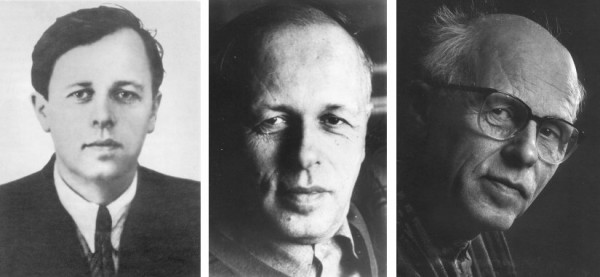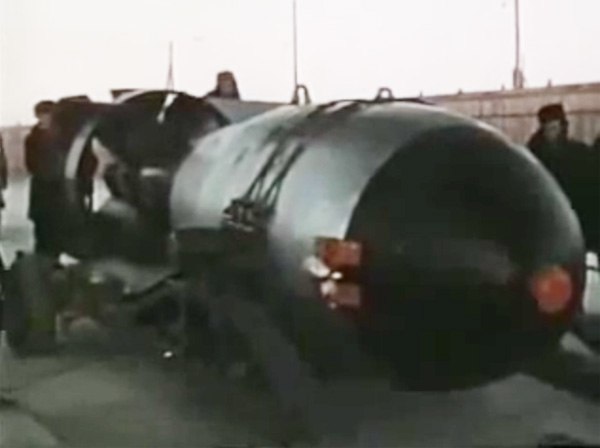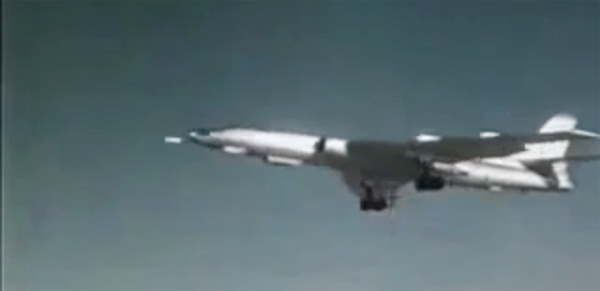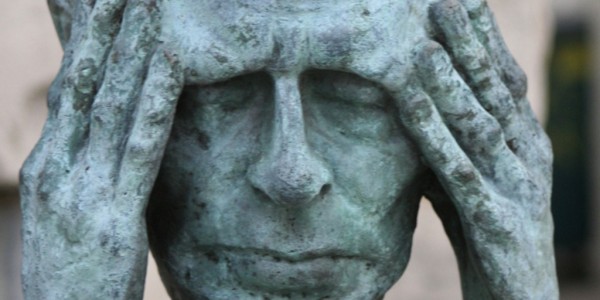The Soviets set off their first megaton-range hydrogen bomb in November 1955. It was the culmination of many years of effort, in trying to figure out how to use the power of nuclear fission to release the power of nuclear fusion in ways that could be scaled up arbitrarily. 1 The Soviet bomb was designed to be a 3-megaton warhead, but they set it off at half strength to avoid too much difficulty and fallout contamination. Unlike the US, the Soviets tested their version version by dropping it out of a bomber — it was not a big, bulky, prototype like the Ivy Mike device. But it was not an uneventful test. The details are little talked about, but it serves as an impressive parable about what can go wrong when you are dealing with science on a big scale.

Andrei Sakharov, from young nuclear weapons designer to aged dissident. Source.
Andrei Sakharov has a stunning chapter on it in his memoirs. It makes for an impressive story in its own right, but Sakharov also identifies the experience as a transformative one in his own thinking about the responsibility of the scientist, as he made his way from nuclear weapons designer to political dissident. 2
Sakaharov starts out by talking about going to Kazakhstan to see the test. He had by this time been assigned two armed KGB officers, known euphemistically as “secretaries,” whose jobs were to act as bodyguards and “to prevent undesirable contacts.” Sakharov claims not to be have been too bothered by them. They lived next door.
The test of the device, code-named RDS-37, was to be the 24th Soviet nuclear test, and was the largest ever tested at the Semipalatinsk test site. This created several logistical difficulties. In order to avoid local nuclear fallout, it was going to be an airburst. The size of the bomb, however, brought up the possibility that it might accidentally blow the bomber that delivered it out of the sky. To avoid this, the bomber was painted white (to reflect the thermal radiation), and a big parachute was applied to the bomb so that the bomber could get away fast enough. Sakharov was satisfied enough with the math on this that he asked if he could ride along on the bomber, but the request was denied.
Sakharov’s account lingers on the incongruity between testing nuclear weapons in beautiful, wild places. Siberia was “a new and spellbinding experience for me, a majestic, amazingly beautiful sight.” He continued: “The dark, turbulent waters of the Irtysh, dotted with a thousand whirlpools, bore the milky-blue ice floes northward, twisting them around and crashing them together. I could have watched for hours on end until my eyes ached and my head spun. Nature was displaying its might: compared to it, all man’s handiwork seems paltry imitation.”

The RDS-37 test device. Source.
A test trial-run on November 18th went smoothly, but the first test attempt, on November 20th, did not. As David Holloway recounts in Stalin and the Bomb, that same Siberian wintery majesty that dazzled Sakharov made for difficult testing conditions. 3 The fully-loaded Tu-16 bomber had to abort when the test site was unexpectedly covered by clouds, making them unable to see the target aiming point and rendering the optical diagnostic systems inoperable. The plane was ordered to land, only now it had a fully-armed experiment H-bomb on board. There was concern that if it crashed, it could result in a nuclear yield… destroying the airfield and a nearby town. The airfield had meanwhile iced over. Igor Kurchatov, the lead Soviet nuclear weapons scientist, drove out to the airfield himself personally to see the airfield. Sakharov assured him that even if it crashed, the odds of a nuclear yield were low. An army unit at the airfield quickly worked to clear the runway, and so Kurchatov ordered the plane to land. It did so successfully. Kurchatov met the crew on the field, no doubt relieved. Sakharov recalls him saying, “One more test like [this one] and I’m retiring.” As for Sakharov, he called it “a very long day.”
Two days later, they gave it another go. This time the weather cooperated, as much as Siberian weather cooperates. The only strange thing was a temperature inversion, which is to say, at higher altitudes it was warmer than at lower altitudes, the opposite of the usual. The meteorologists gave the go-ahead for the testing.
Sakharov stayed at a laboratory building on the outskirts of a small town near the test site. An hour before the test, Sakharov saw the bomber rising above the town. It was “dazzling white,” and “with its sweptback wings and slender fuselage extending far forward, it looked like a sinister predator poised to strike.” He recalled that “for many peoples, the color white symbolizes death.” An hour later, a loud-speaker began the countdown.

The white bomber. Source.
Sakharov described the test in vivid detail:
This time, having studied the Americans’ Black Book 4, I did not put on dark goggles: if you remove them after the explosion, your eyes take time to adjust to the glare; if you keep them on, you can’t see much through the dark lenses. Instead, I stood with my back to ground zero and turned around quickly when the building and horizon were illuminated by the flash. I saw a blinding, yellow-white sphere swiftly expand, turn orange in a fraction of a second, then turn bright red and touch the horizon, flattening out at its base. Soon everything was obscured by rising dust which formed an enormous, swirling grey-blue cloud, its surface streaked with fiery crimson flashes. Between the cloud and the swirling durst grew a mushroom stem, even thicker than the one that had formed during the first [1953] thermonuclear test. Shock waves crisscrossed the sky, emitting sporadic milky-white cones and adding to the mushroom image. I felt heat like that from an open furnace on my face — and this was in freezing weather, tens of miles from ground zero. The whole magical spectacle unfolded in complete silence. Several minutes passed, and then all of the sudden the shock wave was coming at us, approaching swiftly, flattening the feather-grass.
“Jump!” I shouted as I leaped from the platform. Everyone followed my example except for my bodyguard (the younger one was on duty that day); he evidently felt he would be abandoning his post if he jumped. The shock wave blasted our ears and battered our bodies, but all of us remained on our feet except for the bodyguard on the platform, who fell and suffered minor bruises. The wave continued on its way, and we heard the crash of broken glass. Zeldovich raced over to me, shouting: “It worked! It worked! Everything worked!” Then he threw his arms around me. […]
The test crowned years of effort. It opened the way for a whole range of devices with remarkable capabilities, although we still sometimes encountered unexpected difficulties in producing them.
But they soon learned that a bruised bodyguard was the least of the injuries sustained in the test. Scientists and soldiers had been stationed far closer to the blast than Sakharov was. The scientists were fine — they were lying flat on the ground and the blast wave caused them no injury. One of them lost his cool and ran away from the blast, but he was only knocked down by it. But a nearby trench held a platoon of soldiers, and the trench collapsed. One young soldier, in his first year of service, was killed.

RDS-37, detonating. This is considerably sped up; it shows about 50 seconds of footage compressed into only a few seconds. Video source here.
There was also a nearby settlement of civilians affected by the blast wave. In theory it was at a distance remote enough to avoid anything serious; this had been calculated. But the aforementioned inversion layer reflected the shock wave back down to Earth with unusual vehemence — underscoring how even a little misunderstanding of the physics can translate into real problems when you are talking about millions of tons of TNT (something learned by the US a year earlier, at the Castle Bravo test). The inhabitants of the town were in a primitive bomb shelter. After the flash, they exited to see the cloud. Inside the shelter, however, was left a two-year-old girl, playing with blocks. The shock wave, arriving well after the flash, collapsed the shelter, killing the child.
The ceiling of a woman’s ward of a hospital in another nearby village collapsed, seriously injuring many people. Glass windows broke at a meat-packing plant a hundred miles from the test site, sprinkling ground beef with splinters. Windows broke throughout the town where Sakharov was stationed.

RDS-37, seen from a local town. Also sped up. Same source as the previous.
“The consequences of an explosion are hard to predict,” Sakharov concluded.
Had we been more experienced, the temperature inversion would have caused us to delay the test. The velocity of the shock wave increases as the temperature does: if the air temperature rises with altitude, the shock wave bends back towards the ground and does not dissipate as fast under normal conditions. This was the reason the shock wave’s force exceeded our predictions. Casualties might have been avoided if the test had been conducted as scheduled on November 20, when there was no temperature inversion.
As with Castle Bravo, there was a grim, almost literary connection between technical success and human disaster. They had shown the way forward for deployable, multi-megaton hydrogen bombs, but with a real cost — and that cost only an insignificant hint of what would happen if the weapons were used in war. Sakharov concluded:
We were stirred up, but not just with the exhilaration that comes with a job well done. For my part, I experienced a range of contradictory sentiments, perhaps chief among them a fear that this newly released force could slip out of control and lead to unimaginable disasters. The accident reports, and especially the deaths of the little girl and the soldier, heightened my sense of foreboding. I did not hold myself personally responsible for their deaths, but I could not escape a feeling of complicity.
That night, the scientists, the politicians, and the military men dined well. Brandy was poured. Sakharov was asked to give the first toast. “May all of our devices explode as successfully as today’s, but always over test sites and never over cities.”

Sculpture of Andrei Sakharov by Peter Shapiro, outside the Russia House Club & Restaurant on Connecticut Ave in Washington, DC. Image source.
The immediate response was silence. Such things were not to be said. One of the military higher-ups flashed a crooked grin, and stood to give his own toast. “Let me tell a parable. An old man wearing only a shirt was praying before an icon. ‘Guide me, harden me. Guide me, harden me.’ His wife, who was lying on the stove, said: ‘Just pray to be hard, old man, I can guide it myself.’ Let’s drink to getting hard.”
Sakharov blanched at the crudity (“half lewd, half blasphemous”), and its serious implications. “The point of his story,” he later wrote, “was clear enough. We, the inventors, scientists, engineers, and craftsmen, had created a terrible weapon, the most terrible weapon in human history; but its use would lie entirely outside our control. The people at the top of the Party and military hierarchy would make the decisions. Of course, I knew this already — I wasn’t that naive. But understanding something in an abstract way is different from feeling it with your whole being, like the reality of life and death. The ideas and emotions kindled at that moment have not diminished to this day, and they completely altered my thinking.”
- The Soviets tested their first thermonuclear bomb in 1953, the RDS-6s, which used fusion reactions. But it was not a true, multi-megaton capable hydrogen bomb. The 1953 device was “just” a very, very big boosted bomb, where 40 kilotons of fissioning produced 80 kilotons of fusioning which in turn produced another 280 kilotons of fissioning, for 400 kilotons total. The design could not be scaled up arbitrarily, though, and it did not use radiation implosion (like the Teller-Ulam design, known in the USSR as the “Third Idea.” It was a big bomb, but the 1955 test was the design that became the basis for their future nuclear warheads.[↩]
- Andrei Sakharov, Memoirs, trans. Richard Lourie (New York: Knopf, 1990), 188-196.[↩]
- David Holloway, Stalin and the bomb: The Soviet Union and atomic energy, 1939- 1956 (New Haven: Yale University Press, 1994), 314-316.[↩]
- From elsewhere in the Memoirs, it seems that Sakharov may be referring here to the 1950 edition of Samuel Glasstone’s The Effects of Atomic Weapons. There was a hardcover edition that apparently had a black cover. Sakharov notes that the nick-name only “partly” came from the cover; he implies that the contents are “black” as well. However there is nothing about goggles or glare in the version of the text I have, so maybe it is something different.[↩]


What a story. Reminds you of the crew of the ‘Lucky’ Dragon who were the unfortunate victims of another badly miscalculated test.
—Was there an *optimistic* attitude towards a deliverable Soviet Hydrogen Bomb, when the Soviet public was told of it? Was there introspection by anybody in print, in the Soviet Press?
The Soviet press at that point was still highly controlled. I wouldn’t be surprised if there was some kind of announcement of a great success (they did something similar in 1953), but I think introspection is a bit unlikely. But I don’t know.
There are things that truly transcend the capacity to understand. This is an excellent recipe for that sanction.
I will always regret having been born too late to witness an atmospheric nuclear test.
I know what you mean, it must be quite a sight to see. I will console my self with a slightly lesser goal, I’d love to see a rocket launch.
Last September I saw the nighttime launch of the LADEE payload from Wallops Island, and it was spectacular … even though I was watching from the south shore of Long Island, over 200 miles away! I could see the smoke trail and the separation of the first stage.
As for the above-ground nuclear tests, I’m not sure if it ever was possible to see much from public land. Alex probably would be able to say.
I’ve actually stood at the epicenter of where this weapon was tested, at the Semipalatinsk test site (which is in northeast Kazakhstan, not Siberia).
Various sites seem to indicate that this was the RDS-1 ground zero, and the RDS-37 aiming point was the first cross to the south-west, or something like that? I think Sakharov might have been in Kurchatov, about 40 miles northeast. Given how close all of that is to Siberia (and probably the same climate), I can see why Sakharov would have generalized like that…
Yes, that’s correct. My impression is that Sakharov was in Kurchatov (and that the town in the films of the test is Kurchatov-or so they implied when I was in the museum there). The cross was supposedly outlined in chalk and is very hard to distinguish from the ground.
Although I’ve never been to Siberia, one thing I did notice as we left Kurchatov going north to get on the road to Pavlodar is that once you get closer to the Siberian border there are actually trees, which are almost totally absent from the test site.
FWIW, after examining the Atomnyi proekt SSSR document collection my impression is that Sakharov’s memoirs are not always a reliable source.
Re: reliability — oh, no doubt. I take all of these kinds of things with a heavy grain of salt. But that doesn’t make them any less interesting. 😉
I know it’s hard to judge distances, but in that second video the detonation looks insanely close to the village!
a great post, Alex (I’m new at this site, but already a fan)
Just one question- I was a bit (but just a bit!) disappointed when I couldn’t find in this article the exact distances- at what distance sakharov stood, and at what distances were the town that was hit, the soldier and the town in the amazing film?
[…] Bill Lanouette, author of the Szilard biography Genius in the Shadows, e-mailed me after seeing my post on Andrei Sakharov. He noted that according to Rhodes’ Dark Sun, Sakharov was very affected by Szilard’s […]